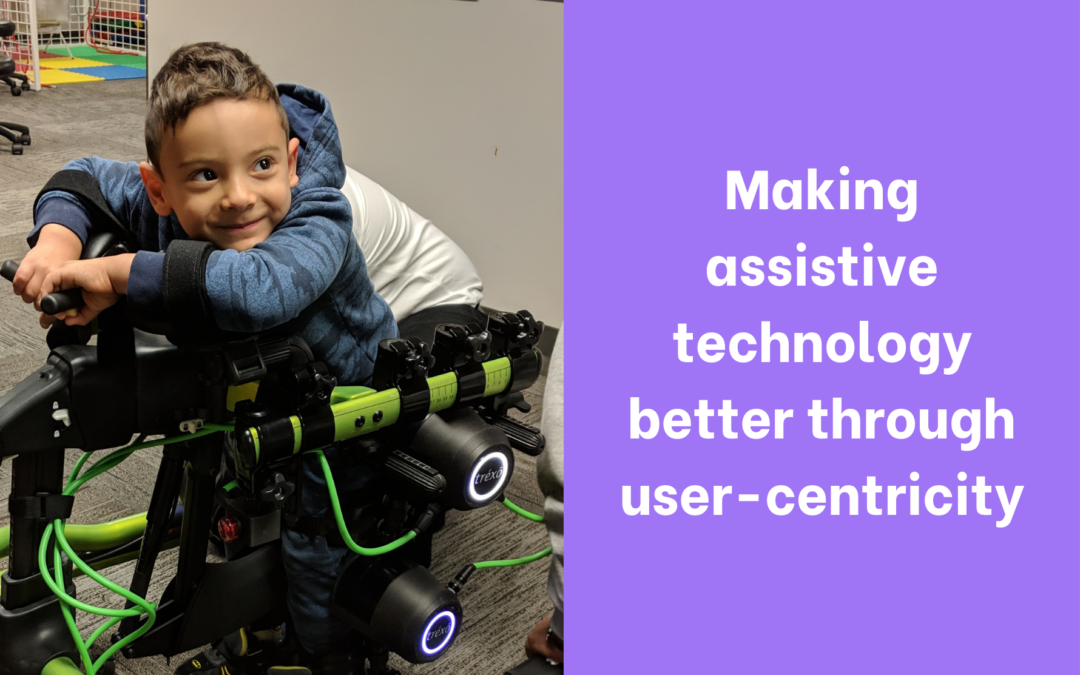We’re learning directly from our end-users about what matters to them in the design of assistive technology.
A glimpse into the experience of our users
Ben is sitting on the Rifton gait trainer seat asking us questions about how the robot works. Around him is our engineering team, some are helping fit the device to Ben’s height, while others are observing and taking notes. Once the set-up is complete, Manmeet holds the tablet up to Ben and asks him to tap the “play” button. Rhythmically, the legs begin to move.
“I’m walking on my own!” Ben exclaims with a big smile on his face.
This is an exciting moment for the 4-year old Ben who isn’t able to walk independently. “With a device like the Trexo”, Manmeet tells him, “maybe you’ll be able to walk on your own at home someday soon”.
While Ben walks around our office, accumulating hundreds of steps in the process, the team is observing and brainstorming design changes to continue improving the device. Within minutes, they can see what requires additional work. With the permission of Ben’s dad, they try out a few new ideas.
This isn’t a rare experience for the Trexo staff. In fact, we shared Leo’s story of walking with the Trexo earlier in June. The Trexo Robotics office has become somewhat popular. Many families who live close to our office visit us to let their children walk in the Trexo. In return, we learn from their experience and ensure that our assistive technology works well and that it truly is assistive.
How we incorporate user-centricity into our design of assistive technology
Over the past year, we have had over 40 visits by children of different ages and abilities. Working together with them, we have been trying to find a solution that meets the needs of each child. With each new member of the Trexo walking club, our secret sauce of hardware and software has been getting better.
Truthfully, our shared experiences have taught us just as much as the cumulative decades of schooling our team holds. For example, it is only with trial and error that we really began to understand how a robotic device and spasticity interact. With that discovery, we decided to find a way for the Trexo to work with the spasticity rather than fight against it.
We also spent time watching physiotherapists put children into the device and take them out, and along the way identified pain points. Jo-Anne Weltman, PT and owner of Smile Therapy for Kids even shared with us what she thinks the benefits of the Trexo are.
We listened to parents who were frustrated about taking time out of their busy schedules for appointments. Essentially, they wanted to maximize every minute with their physiotherapist. Our solutions led to novel strapping mechanisms and a user-friendly design so that kids can spend more time walking in the already time-constrained physiotherapy appointments.
Most importantly, we learned how to think about the different problems we’re trying to address. The challenge of mobility is incredibly complicated. We wrote about the challenges of building assistive technology in a separate post. Working with kids helped us break the problem down into manageable chunks.
Like a puzzle, the pieces have started to fit and reveal a beautiful picture of kids like Ben walking independently.
How user-centricity shaped our assistive technology
A lot of people who aren’t familiar with the unique needs of children with mobility impairments frequently ask us questions about our design. The need for a frame to support the device or the saddle to assist in weight bearing isn’t obvious. The limitations of adult exoskeletons and why they can’t work for children is also ambiguous, especially when you don’t know much about exoskeletons.
We know because we have also been there! That’s why we take the ownership of educating our audience.
A few features we incorporated into the Trexo Plus to meet the needs we identified
- Mobility –It can be difficult to keep yourself entertained on a treadmill, wouldn’t you agree? Children want to explore their environments, this is a normal part of development. And they want to do so independently! Trexo is battery powered to give the freedom of over-ground walking and help the child explore their surroundings.
- Safety –Many of our users have a hard time with balance and weight bearing, that’s whythe frame serves a very important function. Trexo sits on a walker frame to provide support and prevent falls. Without the frame, it would be like wearing metal pants while walking a tightrope; impossible!
- User-friendly controls–We wanted the controls to be intuitive so that the physiotherapist wouldn’t spend time stressing out looking for buttons while trying to run a session. The Trexo app is built on a tablet for this purpose! Realistically most of us have used a smartphone or a tablet at some point.
While our design is different from the status quo, the science behind our technology is sound. We have been researching our device since 2012, and incorporate all of the latest research findings and robotics principles. Our device is at the frontier of robot-assisted rehabilitation and one we’re sure will meet our users’ needs.
We have no intention of changing our philosophy. Our story has shaped our DNA this way, that’s why our devices will always be designed with our users, be it kids or adults.
Loved reading about Ben’s experience? Check out the time Praneit, the boy who inspired the Trexo, tried the device!
Update on Ben’s experience
Ben used the Trexo Home, check out his mom, Andrea’s, thoughts on their experience with the device.
Interested in trying the Trexo Home? Let’s chat about it! Just fill out the form below and we will get in touch with you!


Recent Comments